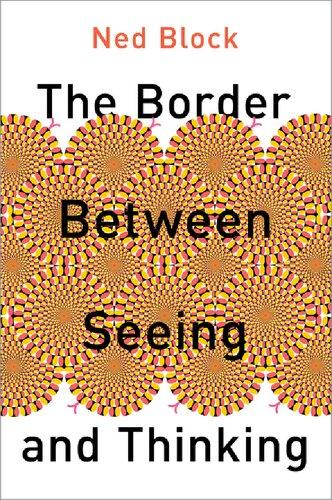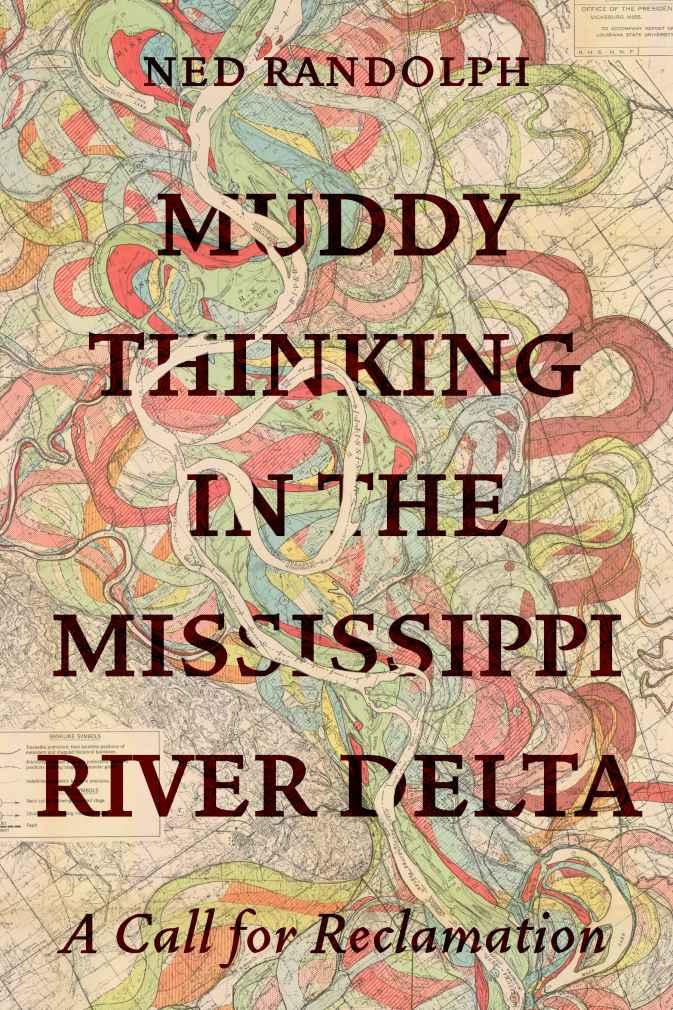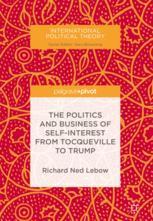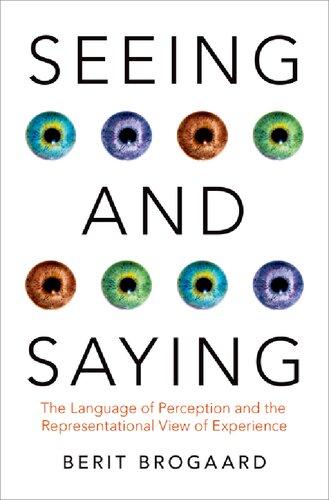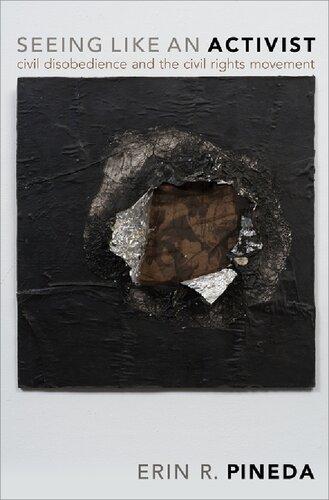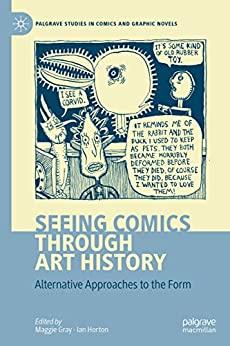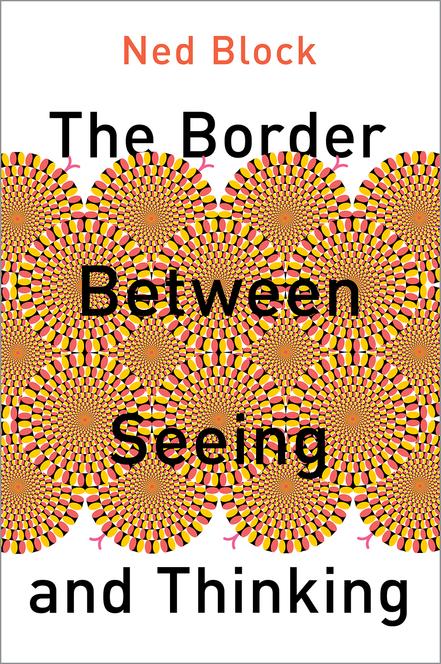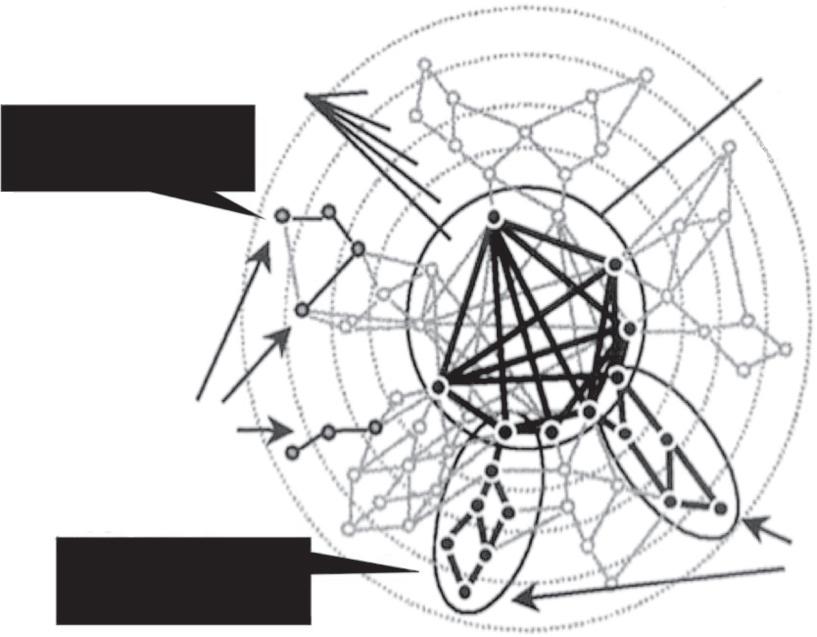1
Introduction
What is the diference between seeing and thinking? Is the border between seeing and thinking a joint in nature in the sense of a fundamental explanatory diference? Is it a diference of degree? Does thinking afect seeing, or, rather, is seeing “cognitively penetrable”? Are we aware of faces, causation, numerosity, and other “high-level” properties or only of the colors, shapes, and textures that—according to the advocate of high-level perception—are the low-level basis on which we see them? How can we distinguish between low-level and highlevel perception, and how can we distinguish between high-level perception and perceptual judgment? Is there evaluative perception or is evaluation a matter of emotion and perceptual judgment? Is perception conceptual and propositional? Is perception iconic or more akin to language in being discursive? Is seeing singular? Which is more fundamental, visual attribution or visual discrimination? Is all seeing seeing-as? What is the diference between the format and content of perception, and do perception and cognition have diferent formats? Is perception probabilistic and, if so, why are we not normally aware of this probabilistic nature of perception? Does perception require perceptual constancies? Are the basic features of mind known as “core cognition” a third category in between perception and cognition? Are there perceptual categories that are not concepts? Where does consciousness ft in with regard to the diference between seeing and thinking? What is the best theory of consciousness and does the perception/ cognition border have any relevance to which theories of consciousness are best? Tese are the questions I will be exploring in this book. I will be exploring them not mainly by appeals to “intuitions,” as is common in philosophy of perception, but by appeal to empirical evidence, including experiments in neuroscience and psychology.
I will orient the discussion around the question of a joint in nature between perception and cognition resting on diferences in format and kind of representation that have been the subject of a great deal of controversy in recent years. Perception is constitutively nonconceptual, nonpropositional, and iconic, but cognition has none of these properties constitutively.
Claims that perception is iconic, nonconceptual, or nonpropositional have been advocated—and opposed—for many years. Stephen Kosslyn is perhaps the most notable advocate of recent years for the iconicity of both perception and mental imagery, but many others have also advocated such views (Block,
The Border Between Seeing and Thinking. Ned Block, Oxford University Press. © Oxford University Press 2023. DOI: 10.1093/oso/9780197622223.003.0001
1981, 1983a, 1983b; Burge, 2010b; Carey, 2009; Kosslyn, 1980; Kosslyn, Pinker, Schwartz, & Smith, 1979; Kosslyn, Tompson, & Ganis, 2006). Zenon Pylyshyn has been a notable opponent of iconicity for both perception and mental imagery (Pylyshyn, 1973, 2003). Similarly, many have advocated nonconceptual and/or nonpropositional perception (Burge, 2010a; Carey, 2009, 2011b; Crane, 1988; Evans, 1982; Peacocke, 1986, 1989). And there are many opponents (McDowell, 1994; Strong, 1930; Wittgenstein, 1953).
Te intended contribution of this book is not that perception is nonconceptual, nonpropositional and iconic, but the elaboration of what that view comes to, engagement with the evidence for and against it; and using this picture of perception to refute widely held theories of consciousness, the global workspace theory and the higher order thought theory, and to argue for a new reason to think there can be phenomenal consciousness without access consciousness. I think I have new evidentially based arguments for other familiar theses. For example, Chapter 6 is devoted to an argument for non-conceptual color perception based on developmental psychology. In the frst few chapters, I will be especially concerned with how to distinguish low-level perception from high-level perception and how to distinguish high-level perception from perceptual judgment.
Tis book is all about evidence. I aim to avoid pronouncements and intuitions. I will also explore the relation between these claims about format, content, and state to modularity and consciousness, and rebut arguments that misconceive the border between perception and cognition. (Te content of a representation is the way it represents the world to be, the way the world has to be for the representation to be accurate. Te format of a representation is the structure of its representational vehicle.)
I also aim to avoid cherry-picking evidence. When I know of evidence that goes against my claims, I will introduce it.
To say that perception is constitutively X is to say that it is in the nature of perception to be X. Te evidence I will present that perception constitutively has certain properties applies most clearly to actual creatures that perceive rather than possible creatures. Te evidence I will be talking about concerns the way actual perceptual mechanisms work. Occasionally I will talk about consequences for robot perception, though I am less certain about those claims.
Although I am arguing for certain constitutive properties of perception, my evidence is almost entirely concerned with vision. I believe the points I am making apply at least to all the spatial senses. Tere is good reason to include smell in the spatial senses (Smith, 2015). Humans can track odors across grass blindfolded, and their tracking deteriorates if they are deprived of the use of one nostril. Humans can also identify the direction of a smell via stereo-olfaction without moving (Jacobs, Arter, Cook, & Sulloway, 2015).
But I will not be talking about the nonspatial senses except in asides such as this one. I will not be talking about proprioception, the sense of balance, thermoception (the sense of temperature, kinesthesia (the sense of movement), chronoception (the sense of time) or others of the perhaps 21 senses (Durie, 2005).
Although there are many types of perception, a wide variety of them obey the same laws of perception such as Weber’s Law (that the discriminability of two stimuli is a linear function of the ratios of the intensities of the two stimuli) and Stevens’s Power Law (that says that perceived intensity is proportional to actual intensity raised to an exponent, where the exponent difers according to stimulus type). Stevens’s Power Law has been shown to apply not only to various forms of visual and auditory intensity but also to many other kinds of perception and sensation. A recent textbook chapter lists the exponents for the following kinds of perception: electric shock, warmth on arm, heaviness for lifed weights, pressure on arm, cold on arm, vibration, loudness of white noise, loudness of 1 KHz tone, and brightness of white light (Zwislocki, 2009). In sum, although my evidence is almost entirely from vision, there is a prima facie case to be made that many of our perceptual modalities have similar underlying natures.
One feature of the treatment of these ideas that will emerge in Chapters 4 and 6 is that perceptual and cognitive states can share the same or at least similar contents, nonconceptual and nonpropositional in the case of perception, conceptual and propositional in the case of cognition. So nonconceptual content is not a kind of content. Chapter 6 will use an extended example in terms of color contents.
Jerry Fodor argued for a joint in nature between perception and cognition based on the distinction between modular (perception) and nonmodular (cognition) processing. Te modularity thesis says perception is a fast, infexible, automatic, domain-specifc system that is informationally encapsulated from other systems, has a fxed neural architecture, a characteristic ontogenetic pace of development, and processes that are themselves largely opaque to other systems (Fodor, 1983). Tis book argues that the joint in nature between perception and cognition does not depend on modularity, and more specifcally that there is a joint and there also is considerable penetration of perception by cognition. Still, there is something to the idea that perception is modular, with only restricted kinds of cognitive penetration. In Chapter 9, I will critique a recent proposal in the spirit of modularity by E. J. Green, but I am friendly to the general approach.
How do we know that we are perceiving a face as a face—as opposed to perceiving a face as having certain colors, lines, curves, textures, shapes, and the like—all low-level properties? To answer that question, we need methods of distinguishing high-level from low-level perception.
Something can look blue, look like a face, look expensive, or look like a piano. But are these kinds of looking all perceptual as opposed to judgmental overlays on perception? Te perceptual representation of blue is low-level, whereas the perceptual representation of faceness is high-level. Low-level visual representations are products of sensory transduction that are causally involved in the production of other (mid- and high-level) visual representations and include representations of contrast, spatial relations, motion, texture, brightness, and color. (Transduction is conversion of signals received by sense organs into neural impulses.) Another low-level property is spatial frequency (roughly, “stripiness”—see Figure 1.1.). Representations at a slightly higher level, sometimes characterized as mid-level, include representations of shapes that indicate corners, junctions, and contours (Long, Konkle, Cohen, & Alvarez, 2016). Highlevel representations include representations of recognizable objects and objectparts, but also causation and numerosity. Some think that conscious perception is never high-level, for example Alex Byrne, Adam Pautz, and Jesse Prinz (Pautz,
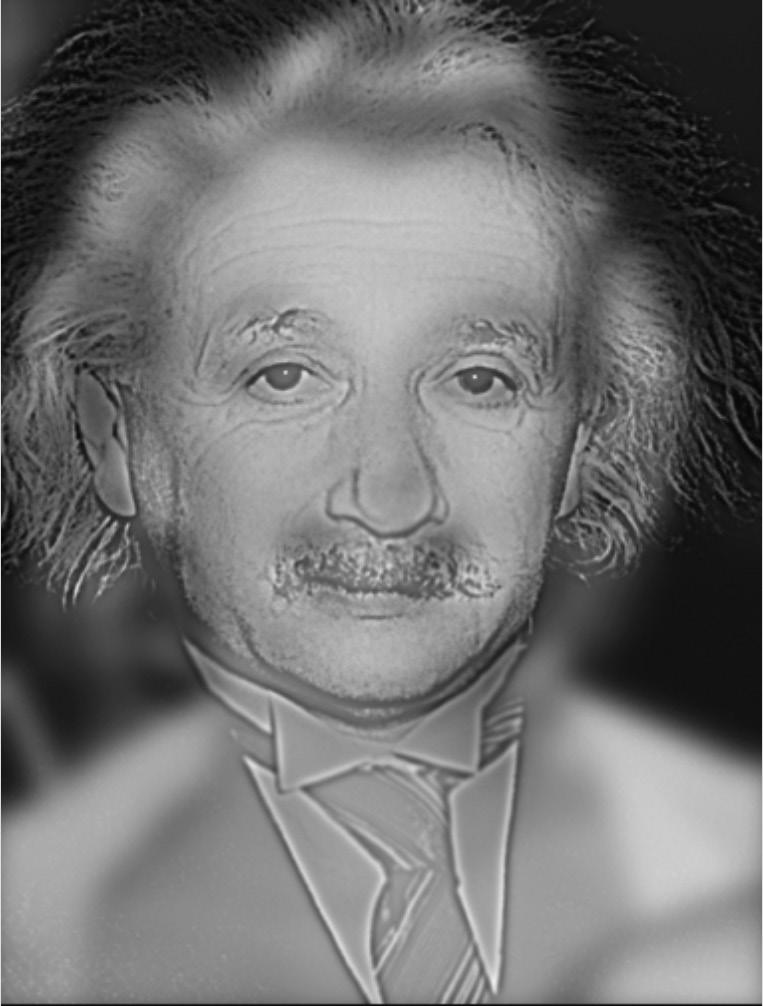
Figure 1.1 Superimposed low-frequency and high-frequency images. From close up you see Albert Einstein (high-frequency image), but from far away (or if you squint) you see Marilyn Monroe (low-frequency image). Any curve can be decomposed into component sine waves. Te spatial frequency of the curve depends on the spatial frequencies of those sine waves. See the Wikipedia article on spatial frequency at https://en.wikipedia.org/wiki/Spatial_frequency. Tanks to Aude Oliva for the fgure. (See Oliva, Torralba, & Schyns, 2006.)
2021; Prinz, 2002; Siegel & Byrne, 2016) and that what happens when it seems that something looks like a face is that we perceive lower-level properties while judging that certain high-level properties apply. Tose who advocate high-level perception are ofen said to advocate rich as opposed to thin perception (Siegel, 2010; Siegel & Byrne, 2016).
Although I will be arguing at length that we do perceptually represent some high-level properties, I agree with the skeptics that it is a mistake to postulate rich content solely on the ground that a perceiver can visually recognize something. For example, I can visually recognize that something is a pipe wrench without seeing it as such.
One view of the rich/thin debate that is not the one I am endorsing is that the thin view is one in which we perceive low-level properties “directly” and high-level properties “indirectly.” Tis picture, sometimes called the “layering” conception, is that “we see more abstract and worldly things in and by seeing simpler and more primitive ones” (Lycan, 2014, p. 7). I think we visually attribute faceness, causation, and numerosity directly.
High-level perception is to a large extent causally dependent on low-level perception but not totally dependent on low-level perception. For example, there are direct connections between subcortical structures like the amygdala and the high-level fusiform face area (Herrington, Taylor, Grupe, Curby, & Schultz, 2011). Te amygdala is activated by fearful faces by a pathway that skips the low-level perceptual analysis of early visual cortex (McFadyen, Mermillod, Mattingley, Halász, & Garrido, 2017). Further, even to the extent that high-level perception is causally dependent on low-level perception, that doesn’t make high-level perception indirect in the sense that high-level percepts are composed of low-level percepts. High-level perception in the sense I am using is just the perceptual attribution of high-level properties.
What is the evidence that we visually represent some high-level properties? I will be addressing this question in more detail later, especially in Chapter 2, but I will give one line of evidence here having to do with visual agnosia (a term due to Freud). My argument will be superfcially similar to one given by Tim Bayne (2009), and one reason for introducing the argument in the introductory chapter is that the diference between my argument and Bayne’s illustrates a key feature of the methodology of this book.
A nineteenth-century classifcation system of agnosias due to Lissauer (Shallice & Jackson, 1988) that is still useful distinguishes between apperceptive agnosia, in which subjects have problems with grouping of perceptual elements, and associative agnosia, in which grouping is normal or close to normal but recognition is not. Apperceptive agnosia is now more commonly referred to as “visual form agnosia.” (Te latter term is used in the second [but not the frst] edition of Martha Farah’s classic book [Farah, 2004].) Apperceptive agnosics can
ofen see color and texture but cannot see shapes and ofen have trouble telling whether they are seeing one object or two objects. Tey have difculty copying drawings even when they can draw from memory with their eyes closed.
Associative agnosics can ofen copy drawings well without knowing what they are copying. Associative agnosia is characterized by failure to apply highlevel visual properties, even though associative agnosics ofen have normal recognition through nonvisual sensory modalities and intact low-level vision. For example, an associative agnosic might be unable to visually recognize that something is a dog despite being able to recognize that something is a dog haptically and despite having the concept of a dog. Hans-Lukas Teuber described associative agnosia as “percepts stripped of their meaning” (quoted in Goodale & Milner, 2005, p. 13).
In addition to broad visual associative agnosia there are also specialized associative agnosias such as prosopagnosia, the inability to recognize faces despite intact low-level perception. Color agnosia, a type of associative agnosia, is discussed in Chapters 4 and 6. A recent paper reported an even more specifc agnosia, agnosia for the digits ‘2’ through ‘9.’ Te patient could recognize ‘0’ and ‘1’ and letters of the alphabet. Te patient was an engineering geologist with a degenerative brain disease. Although he could not recognize the eight mentioned digits, he could do mental arithmetic. He came up with a diferent system of representing the eight digits and set up his computer to use the new numerals on the screen so that he could keep working (Kean, 2020; Schubert et al., 2020).
Apperceptive agnosics don’t demonstrate the existence of low-level without high-level perception, since what they lack is a kind of low-level perception involving low-level grouping. However, patients whose perceptual grouping is normal but have associative agnosia have low-level perception without highlevel perception. Te existence of associative agnosics is an excellent reason to believe that there is high-level perception and high-level perceptual content.
I think this point establishes that there is high-level perceptual content, but it does not show that there is high-level perceptual phenomenology, that is conscious high-level content (cf. Bayne, 2009). But separating the issue of high-level perceptual phenomenology into the question of high-level perceptual content and whether that content can be conscious allows us to get a grip on the latter question. And this is the point of methodology that I am illustrating here.
It is widely agreed among those who study the neuroscience of consciousness that specifc phenomenal contents are based at least in part in the brain circuits that process that kind of content. For example, visual brain area MT+ processes motion perception, both 3D and 2D motion. Te evidence is partly correlational—even illusory motion and motion aferefects involve activation in MT+ (Tootell et al., 1995), but the conclusion is also supported by stimulation to MT+. Indeed the experience of specifc directions of motion is produced
by stimulation to distinct subareas of MT+ (Salzman, Murasugi, Britten, & Newsome, 1992).
Although we know that activation in MT+ is part of the neural basis of motion experience, what we don’t know is what else has to happen for (conscious) motion experience to occur. Tough we don’t know, theorists do make claims about what else has to happen. For example, the global workspace theory (to be discussed in detail in Chapters 4 and 13) says that the motion representational contents must be “globally broadcast.”
What is global broadcasting? Perception sparks competition among neural “coalitions” in perceptual areas in the back of the head. (See Koch, 2004, for a readable account of neural coalitions and (Dehaene, 2014) for a readable presentation of the global workspace account.) Tese coalitions involve feedback/ feed-forward loops known as recurrent activations. Te recurrent activations in the back of the head trigger “ignition,” in which a winning neural coalition in perceptual areas links up with frontal circuits via “workspace neurons” that link the front and back of the head. Te result is a systemwide mutually supporting neural coalition that advocates of the global workspace model describe as broadcasting in the global workspace. See Figure 1.2. According to the global workspace theory, representations of motion based in MT+ being globally broadcast is constitutive of perceptual consciousness of motion.
Te “global workspace” model of consciousness (Dehaene, 2014) is illustrated in Figure 1.2. Te outer ring indicates the sensory surfaces of the body. Circles are neural systems and lines are links between them. Filled circles are activated systems and thick lines are activated links. Activated neural coalitions compete with one another to trigger recurrent (reverberatory) activity, symbolized by the
hierarchy of modular processors
high-level processors with strong long-distance interconne ctivity processors mobilized into the conscious workspace
Figure 1.2 Schematic diagram of the global workspace. Dark pointers added. I am grateful to Stan Dehaene for supplying this drawing.
ovals circling strongly activated networks. Sufciently activated networks trigger recurrent activity in cognitive areas in the center of the diagram and they in turn feed back to the sensory activations, maintaining the sensory excitation until displaced by a new dominant coalition. Not everyone accepts the global workspace theory as a theory of consciousness (including me), but it does serve to illustrate one kind (again, not the only kind) of competition among sensory activations that in many circumstances is “winner-takes-all,” with the losers precluded from consciousness. (As we will see in Chapter 7, there is a revised version of the global workspace theory, the global playground theory, that is arguably superior.)
I have argued that recurrent activations confned to the back of the head can be conscious without triggering central activation. Because of local recurrence and other factors, these are “winners” in a local competition without triggering global workspace activation (Block, 2007a). Strong recurrent activations in the back of the head normally trigger “ignition,” in which a winning neural coalition in the back of the head spreads into recurrent activations in frontal areas that in turn feed-back to sensory areas. See Figure 1.2. As Dehaene and colleagues have shown, such locally recurrent activations can be produced reliably with a strong stimulus and strong distraction of attention (Dehaene, Changeux, Nacchache, Sackur, & Sergent, 2006). (Since I am concerned in most chapters of this book with normal perception, I won’t say much about my disagreement with the model until we get to the chapter on consciousness. But for the record, I think the global workspace model is a better model of conceptualization than of consciousness.)
Here is the point: What is true for low-level perceptual representations such as the representation of motion is also true for high-level perceptual representations, such as face-representations based in the fusiform face area. When high-level perceptual representations are broadcast in the global workspace they give rise to high-level conscious phenomenology—according to the global workspace theory. So the global workspace account plus the fact that there is high-level perceptual content leads to the conclusion that there is high-level perceptual phenomenology. (I am assuming that the high-level representations are sometimes broadcast in the global workspace, but that is obvious enough.) So if we assume the global workspace account of consciousness, we can move from the high-level perceptual content shown by the agnosia evidence to high-level perceptual phenomenology.
Te frst-order recurrent activation account of conscious content is basically a truncated form of the global workspace account: It identifes conscious perception with the recurrent activations in the back of the head without the requirement of broadcasting in the global workspace (Block, 2005b; Lamme, 2003). First-order theories do not say that recurrent activations are by themselves suffcient for consciousness. Tese activations are only sufcient given background conditions. Tose background conditions probably include intact connectivity
with subcortical structures. (Te cortex is the thin sheet covering the brain, the “gray matter.”) Tis kind of connectivity is disrupted under general anesthesia (Alkire, 2008; Golkowski et al., 2019).
Tat is, according to the frst-order recurrent activation account, the active recurrent loops in perceptual areas plus background conditions are enough for conscious perceptual phenomenology. So long as high-level representations participate in those recurrent loops, conscious high-level content is assured. So if we assume the frst-order recurrent activation account of consciousness, we can move from the high-level perceptual content shown by the agnosia evidence to highlevel perceptual phenomenology.
I favor the frst-order point of view. If the frst-order point of view is right, it may be conscious phenomenology that promotes global broadcasting, something like the reverse of what the global workspace theory of consciousness supposes. (“Something like”: First-order phenomenology may be a causal factor in promoting global broadcasting; but according to the global workspace theory, global broadcasting constitutes consciousness rather than being caused by it.)
I believe that the same line of thought will apply to any neuroscientifc theory of consciousness. All will have to agree that perceptual representation of motion in MT+ plus something else—e.g., certain relations to other brain activations or to behavior—are the basis of conscious experience of motion. It is difcult to imagine a remotely plausible candidate for the “something else” that applies to lowlevel representations such as activations in MT+ but does not apply to high-level activations such as activations in the fusiform face area. Tis point is the core of my argument for high-level phenomenology.
Some will reject the application of this idea to high-level phenomenology, but that rejection will have to be based on an independent doctrine that there is no high-level perceptual phenomenology. For example, Jesse Prinz’s AIR theory (attended intermediate level representation) holds that conscious perception is a matter of mid-level perceptual representations being modulated by attention in a way that allows for availability to working memory—albeit indirectly, via encoding of high-level representation (Prinz, 2012). (Working memory will be discussed later in this chapter and in Chapters 5 and 6.) My point here is that Prinz’s theory fts the mold I have described for low-level contents such as motion contents, and he is only able to avoid the extrapolation to high-level phenomenology by explicit stipulation that only mid-level representations can be conscious.
Representationists (also known as representationalists or intentionalists) among philosophers, such as Alex Byrne and Michael Tye, would also be committed to high-level perceptual phenomenology if they accept my argument that there is high-level perceptual representation (Byrne, 2001; Tye, 2019). Representationists hold that the phenomenology of perception is grounded in or
determined by its representational content, so high-level content requires highlevel phenomenology. (Tey require further conditions, e.g., that the high-level representations are poised for a role in thought and report, but there is no reason to suppose that these conditions do not apply to high-level representations.)
In sum, many widely accepted perspectives in both neuroscience and philosophy support the move from the existence of high-level perceptual content to the conclusion that there is high-level perceptual phenomenology.
Adam Pautz has argued that the hypothesis of visually representing clusters of low-level properties is methodologically superior to the hypothesis of representing high-level properties. Te low-level account is alleged to be more uniform, applying both to faces and to Byrne’s “greebles,” invented stimuli that are used to study object perception. And the low-level account is alleged to be more parsimonious since the high-level account postulates an extra layer. However, these arguments can’t explain the evidence of the sort just presented from agnosias for specifc high-level representation. Further, as mentioned earlier, high-level perception has causal sources that are causally independent of low-level perception so high-level perception cannot be reduced to low-level perception.
Now we can return to the use of associative agnosias in arguing for high-level phenomenology. As I mentioned, Tim Bayne (2009) uses associative agnosia to argue for high-level phenomenology. He notes that associative agnosics have low-level perceptual phenomenology, but that it is “extremely plausible” to suppose that the result of the agnosia is that “the phenomenal character of his visual experience has changed” (p. 391). However, introspective judgments about highlevel phenomenology are hard to agree on, as anyone who has argued with an opponent about them realizes. How sure can anyone be that they have the experience of visually attributing faceness as opposed to visually attributing colors, shapes, and textures?
Further, as Robert Briscoe (2015) points out, those who do not believe in highlevel phenomenology (such as Prinz) will regard this argument as questionbegging. Tey will think that the associative agnosics have lost recognition of high-level properties without having lost any alleged phenomenology that is specifc to high-level properties.
Note however, that my argument is not subject to the problem that Briscoe raises. I have used associative agnosia and its diference from visual form agnosia to argue for high-level perceptual representation—without assuming anything about phenomenology or consciousness. Ten I have added that all the main contenders for scientifc accounts of how phenomenology relates to perceptual representation have the consequence that there is high-level perceptual phenomenology.
I think this two-step argument for high-level phenomenology is more convincing than other arguments with the same conclusion (Peacocke, 1983; Siegel, 2010). At least it replaces reliance on intuitions about the phenomenology of experience with appeal to the scientifc literature.
I am mentioning this issue in the introductory section of Chapter 1 because it illustrates the utility of the methodology of this book. I am discussing perception without consideration of consciousness or phenomenology, and then, once certain conclusions about perception are “established,” I will be arguing—in Chapter 13—that they provide arguments against “cognitive” theories of consciousness such as the global workspace and higher order theories.
More discussion of what the distinction between low-level and high-level comes to in terms of the visual hierarchy will come in the discussion in Chapter 2 and in the section of Chapter 4 on Bayesian inference.
I will be giving further arguments that there is high-level perception, though I do not think we have high-level representation of every observable property— observable in the sense that we can detect its presence perceptually. For example, we can ofen tell visually whether something is expensive but I doubt that expensiveness is visually represented. My main focus, however, is the diference between seeing something as, for example being a face, and forming a minimal immediate direct perceptual judgment that it is a face, the latter being the most perception-like of cognitive states. (More on this below.) Te main issue of this book is what that diference is and why it is explanatorily important. Te diference between high-level and low-level perception mainly comes in because it can ofen be hard to distinguish cognitive representations from high-level perceptual representations.
One feature of the scientifc approach to perception that frustrates some readers is that there are observable properties that probably are not represented in perception. I just mentioned the property of expensiveness. Other such properties are being a baseball bat or a CD case. Endre Begby describes Burge’s view that probably we don’t perceptually represent these properties as “oddly reductive” (Begby, 2011). I think that what seems odd to many people is that we can tell pretty well by looking whether something is a baseball bat and whether it is a CD case. We can even do a visual search for baseball bats and CD cases. Te reader should keep in mind that the issue here is whether, when one searches for a baseball bat, one is searching on the basis of low-level properties such as color, shape, and texture or whether a representation of baseball bats functions directly in visual search. Tis is a real experimental issue in many cases. For example Rufn van Rullen argues on the basis of experimental evidence that when one searches for a face in a scene, one uses representations of low-level properties and does not use a high-level face representation directly in search (VanRullen, 2006).
Te cognitive state that is hardest to distinguish from a perception is a minimal immediate, direct perceptual judgment based on that perception. If I am perceiving a face, I ofen simultaneously judge on the basis of that perception that there is a face. When I speak of immediate perceptual judgment, I am talking about a cognitive state that is noninferentially triggered by perception. A direct perceptual judgment is based solely in the perception with no intermediary, inferential or otherwise. I can have a direct immediate perceptual judgment that the two lines in the Muller-Lyer illusion are unequal even when I know that they are actually equal. Tus in the case of known illusions, we have opposite cognitions. We have a perceptual judgment that the lines are unequal and knowledge that they are equal.
Of course, the content of an immediate perceptual judgment has to do with the way the world presents itself in perception. More specifcally, what I mean is a minimal immediate direct perceptual judgment. A minimal perceptual judgment conceptualizes each representational aspect of a perception and no more. Later in this book I will use “perceptual judgment” to mean minimal immediate direct perceptual judgment, ofen leaving out everything but the “perceptual judgment.”
Given my defnition of “perceptual judgment,” you may wonder whether there really is a diference between perception and perceptual judgment. Tis whole book is aimed at showing that there is such a diference and what that diference is. Chapter 2 concerns markers of perception that are not markers of perceptual judgment. And the penultimate section of Chapter 3, “Bias: perception vs. perceptual judgment,” gives a simple nontechnical example of how one could get empirical evidence that a mental state is a perceptual judgment rather than a perception. Tat issue stems from some shootings by police of unarmed Black men in which the police seemed to be saying that they “saw” a gun. Tis section presents one item of evidence that such reported states were perceptual judgments rather than perceptions. Readers who are especially interested in that issue could read that section now, since it does not presuppose anything in the book that comes before it.
A concept of something in my terminology is a representation that functions to provide a way of thinking of what it is a concept of. Oedipus had at least two concepts—i.e., two ways of thinking of his mother, one we could describe as “Mom,” and another when he married her (perhaps Greek analogs of “Jocasta” or “Sweetie”). He then found out that, tragically, the two ways of thinking of her, the two concepts of her, were ways of thinking of the same person. Some uses of the term “concept” link it to discrimination and others to categorization (Connolly, 2011). As we will see in Chapter 6, there is perceptual categorization in the absence of the ability to use a representation in thought and reasoning. In my terminology, these cases exhibit nonconceptual perceptual categorization. Te ways of representing that are involved in concepts play a role in propositional thought or reasoning—that is defnitional in my use of the term “concept.”
What is meant by “cognition”? A prescientifc characterization is that it constitutively involves capacities for propositional thought, reasoning, planning, evaluating, and decision-making. (I won’t be talking about the conative attitudes [e.g., wanting] or emotions.) Some insects—for example, the nonsocial wasp—can perceive but are not good candidates for propositional thought. Perceptual judgment (i.e., minimal immediate direct perceptual judgment) can be unconscious and automatic. (I will have little to say about emotions, moods, and other mental states that are neither a matter of just perception nor just cognition.)
My usage of the terms “cognition” and “perception” is consonant with much of the recent literature on perception (Firestone & Scholl, 2016a; Pylyshyn, 1999), but some restrict the term “perception” to what I am calling low-level perception (Linton, 2017) and others use “cognition” to encompass mid-level and high-level perception as both perception and cognition (Cavanagh, 2011). Tis usage is responsible for the term “visual cognition” to mean mid- and high-level vision. For example, here is how Patrick Cavanagh defnes “visual cognition” (Cavanagh, 2011, p. 1538):
A critical component of vision is the creation of visual entities, representations of surfaces and objects that do not change the base data of the visual scene but change which parts we see as belonging together and how they are arrayed in depth. Whether seeing a set of dots as a familiar letter, an arrangement of stars as a connected shape or the space within a contour as a flled volume that may or may not connect with the outside space, the entity that is constructed is unifed in our mind even if not in the image. Te construction of these entities is the task of visual cognition.
Cavanagh seems to exclude low-level perception with the phrase “base data,” and the example of a familiar letter brings in high-level perception.
Consider the Necker cube (pictured in Chapter 2). It can be seen as having a front surface pointing to the lower lef or, alternatively, the upper right. Tese are mid-level diferences since they have to do with computation of surface representations. By Cavanagh’s defnition, the diference counts as cognitive— and also a diference in mid-level vision. Tis way of talking would preclude a joint in nature between perception and cognition, so I will stick with an anchor for “cognition” in propositional thought, reasoning, planning, evaluating, and decision-making. (See the section on conceptual engineering later in this chapter for a discussion of principles of clarifying the notions of perception and cognition.)
Conceptions of cognition that link it to thinking and reasoning have been called the conservative approach by Cecilia Heyes (Bayne et al., 2019). Of the conservative view, she says (p. R611) it “has a venerable history in Western
thought but it’s out of kilter with contemporary scientifc practice. It implies that much of the research done by those who identify as cognitive scientists—for example, work on the behaviour of plants, shoals of fsh and swarms of bees—has nothing to do with cognition.”
Although using the term “cognition” in the “liberal” manner that Heyes prefers may have some advantages and it might identify some kind of a joint in nature, it won’t be the joint between seeing and thinking. Individual bees may have some thought, but the swarms of bees and shoals of fsh don’t and plants don’t.
Perhaps the most signifcant difculty for the perception/cognition joint has been “core cognition,” systems that appear to constitute a mental kind that is both paradigmatically perceptual and paradigmatically cognitive. Te existence of a third category does not in itself impugn a joint. Glasses are normally rigid in the manner of solids but have the amorphous structure of liquids. Glasses do fow, more quickly at some temperatures than others, and they do not have the “shear” properties of solids. Glasses have a level of molecular organization intermediate between that of liquids and that of solids (Curtin, 2007). Indeed, one newly discovered form of glass resembles solids in that the molecules cannot change orientation but resembles liquids in that the molecules can move freely (in the sense of translational motion) in all directions (Roller, Laganapan, Meijer, Fuchs, & Zumbusch, 2021). No one would think that the existence of these intermediate types impugns the important explanatory signifcance of the division of matter into gas, liquid, and solid.
However, the problem posed by core cognition goes beyond providing a third category. Te problem is that perception and cognition each are defned by a set of properties that have their own explanatory unity and core cognition purports to spoil that unity by combining fundamental features of both perception and cognition.
Two of the most dramatic cases of core cognition are mental representation of causation and approximate numerosity (Carey, 2009; Carey & Spelke, 1994). I will argue in Chapter 12 that in these cases there are perceptual analogs of our cognitive representations of causation and numerosity and that some of the key phenomena can be seen as simply perceptual. Also, some can be seen as cognitive phenomena that utilize perceptual materials, as when we think about something by thinking about what it looks like. In their writings on core cognition, Susan Carey and Elizabeth Spelke have advanced a view of core cognition as combining both perceptual and cognitive features in a single type of representation. I will be arguing for a diferent view, in which the category of “core cognition” is best thought of as mixing fundamentally diferent kinds of representations in a single system. In a homogeneous mixture, like air or sugar water, the distinct kinds are not easily discernable. In a heterogeneous mixture, like smoke (gases plus particles) or salad dressing (oil plus vinegar), there are diferent kinds that are
discernable. I am saying that core cognition may be a heterogeneous mixture of perception and cognition.
Tere are other heterogeneous mixtures of perception and cognition. Here is an example of the use of perceptual materials in cognition: when we use a perceptual simulation involving perceptual representation of a sofa and a doorway to think about whether the sofa will ft through the doorway. It is well established that we use the mental imagery system to do something ofen described as “mental rotation” in such reasoning, and the mechanisms of mental imagery are substantially (but not completely [Kaski, 2002]) shared with perception (Block, 1983a). Another example: the use of perceptual color representations to consider the question of which green color is darker, that of a Christmas tree or that of a frozen pea. In this case, the reasoner uses two diferent perceptual concepts of color shades. Tese perceptual concepts are conceptualized percepts, i.e., percepts that have been incorporated into a conceptual structure. Another type of conceptualized percept would be a descriptive concept with a slot for perceptual materials (Balog, 2009b; Block, 2006; Papineau, 2002).
But why don’t these examples and the existence of conceptualized percepts show there is no joint in nature? Te answer is that the joint is between perception on the one hand and types of states that may use perceptual materials, but not constitutively, on the other. Tis argument will be explored in greater detail later in the section Conceptual Engineering (p. 46). I will argue that perception should be restricted to what might be called pure perception, perception that does not occur as part of a judgment or as part of a working memory representation. (Working memory is a mental scratch pad that will be described in detail later, mainly in Chapters 5 and 6.) Pure perception is perception without any cognitive envelope.
Perceptual simulations used in cognition do not have all the properties of perception. I will present evidence in Chapter 2 that a basic kind of competition between perceptual representations that is characteristic of perception does not obtain with perceptual representations in working memory. Further, there is reason to believe that the perceptual representations of colors used in working memory representations do not allow for fne-grained colors, the minimal shades of perception.1 Finally, perceptual simulations used in working memory do not have the phenomenology characteristic of conscious perception.
1 Tere is, however, evidence that spatial resolution is not decreased in working memory (TamberRosenau, Fintzi, & Marois, 2015). At the neural level, Zhao et al. used an orientation working memory task while the subjects were undergoing fMRI scanning. Tey found that the earliest cortical representations (in V1) on the opposite side from the stimulus lost precision over time, but oddly the representations on the same side as the stimulus did not lose precision. Tus it may be that there are two diferent kinds of spatial representations involved in spatial working memory (Zhao, Kay, Tian, & Ku, 2021).
(Compare hearing a phone number and rehearsing it while you look for your phone.) Tese three points indicate deep diferences between perception and perceptual materials used in working memory.
One consequence of the thesis of this book is that certain kinds of machine “vision” are not really cases of vision or even of perception. Tis issue will be explored in Chapter 6, where I will discuss a robot whose cameras output propositional representations concerning the properties of pixels in the camera’s sensor. If those representations are treated as premises in inferences on the basis of which the robot infers the environmental causes of those stimulations, then the robot would have direct sensory production of thought without perception.
One upshot of the ideas in this book for epistemology is that it is a mistake to think of the way perception justifes perceptual belief in terms of inference from perceptual contents to belief contents. Another upshot has to do with intentionality. Te kind of intentionality involved in perception is diferent from although perhaps the source of the intentionality of belief (Neander, 2017; Shea, 2018).
Consciousness
As noted earlier, throughout most of this book, I will be concerned with perception rather than conscious perception. Te border I am talking about is the border between perception—whether conscious or unconscious—and cognition—whether conscious or unconscious. In part, this focus stems from the perception literature (cf. Teufel & Nanay, 2017). Much of the experimental work on perception and cognition does not address the issue of whether the efects are conscious or unconscious. But in part this focus refects the view that perception is a natural kind that includes both conscious and unconscious perception (see Block, 2016a; Block & Phillips, 2016; and Phillips, 2015, for both sides on this view). (A similar idea applies to the relation between conscious and unconscious control of behavior (Suhler & Churchland, 2009).)
In endorsing the methodological priority of perception over conscious perception, I am not endorsing a view that perception is metaphysically and explanatorily prior (Miracchi, 2017) to consciousness. Tere are many conscious states that are not perceptual. Perception and consciousness are overlapping natural kinds, neither of which has priority over the other.
Of course the phenomenology of perception is conscious and is part of . . . perception! Some visual phenomena occur in both conscious and unconscious perception, for example the phenomenon of binocular rivalry to be described in Chapter 2. Also, illusory contours probably are present in unconscious vision, since, as will be described in Chapter 2, they occur in insects, and occur so early in visual processing in primates that they probably partially precede conscious
perception. However, other perceptual phenomena may only occur in conscious vision, for example, perceptual pop-out.
In Chapter 6 I will argue for nonconceptual color perception in children. Ten in Chapter 13 I will leverage that point to argue that these children have phenomenal-consciousness of color without access-consciousness of color.
Pure perception
Any perception that we notice will inevitably involve conceptualization—as part of the cognitive process of noticing the perception. But there may be creatures whose perceptions are always pure, never involving cognition. Wasps have well-developed visual systems. For example, wasp vision exhibits many of the standard visual constancies. Peter Godfrey-Smith has noted that despite their excellent vision, wasps have short lives with highly stereotyped action patterns and show little or no sign of a cognitive or afective life (Godfrey-Smith, 2017).
Tis is true of the solitary wasp species, for example the sphex wasp. Tere are thousands of wasp species, with the social wasps being more sophisticated. One social wasp (the paper wasp) has been shown to be capable of a kind of transitive inference-like behavior (Tibbetts, Agudelo, Pandit, & Riojas, 2019). Bees have been shown to learn matching relations between numerosities of 3, 2, and 1 items and symbols, and also between symbols and numerosities (Howard, AvarguèsWeber, Garcia, Greentree, & Dyer, 2019a). But bees trained on matching symbols to numerosities did not generalize to matching numerosities to symbols. And conversely. Although bees have been shown capable of such kinds of symbolic associations with number, they failed the transitivity test. Tibbetts et al. speculate that sensitivity to transitive relations evolved in the paper wasp because its social structure involves dominance hierarchies among individuals. Bees do not have social ranks of the same sort, and of course solitary wasps have no social ranks. My discussion below concerns solitary wasps, not social wasps.
Jumping spiders have been shown to distinguish between biological and nonbiological motion (De Agrò, Rößler, Kim, & Shamble, 2021). De Agrò et al. used displays of 11 moving dots. If the dots are on human joints, displays look like moving humans to human observers. De Agrò et al. constructed similar displays based on spider joints and presented spiders with those displays as well as displays based on moving geometrical fgures and random displays. Tey found that the spiders looked longer at the nonbiological motion. Tis diference may refect high-level perception as shown in humans of biological motion. Alternatively, it could refect cognition.
Flying insects are subject to evolutionary pressure to reduce the size of their brains (Godfrey-Smith, 2017). Godfrey-Smith speculates (in a talk at NYU) that the lifestyle of wasps, combining excellent vision, short lifespan, and limited
